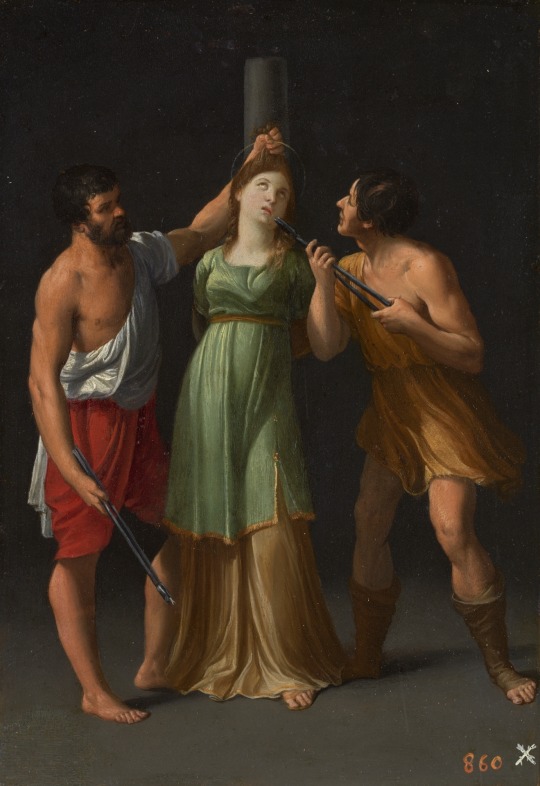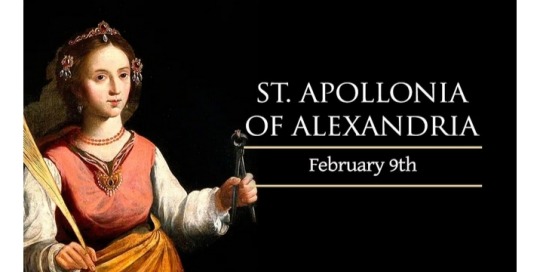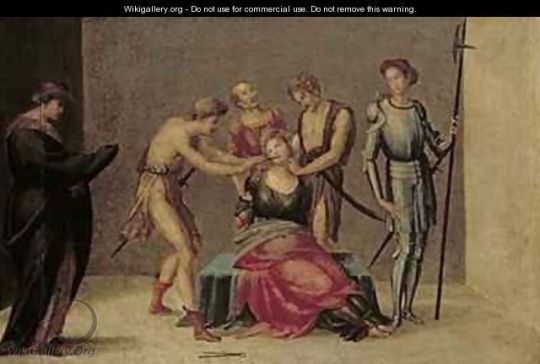#The martyrdom of Saint Apollonia
Text

Guido Reni - The martyrdom of Saint Apollonia, 1600-03.
See also >> (x)
#Guido Reni#The martyrdom of Saint Apollonia#martyrdom#martyr#martyrs#dragging#torture#red hair#Saint Apollonia#death#murder
11 notes
·
View notes
Text

Unknown Artist
The martyrdom of Saint Apollonia
a polychrome and sculpted wood panel, 55 x 65 x 3 cm, 19th century
13 notes
·
View notes
Text

Guido Reni - The Martyrdom of Saint Apollonia
7 notes
·
View notes
Text
SAINT OF THE DAY (February 9)

St. Apollonia was a holy virgin who suffered martyrdom in Alexandria during a local uprising against the Christians in the early 3rd century.
During festivities commemorating the founding of the Roman Empire, a mob began attacking Christians.
The great Dionysius, then Bishop of Alexandria (247-265), related the sufferings of Apollonia:
"Men seized her and, by repeated blows, broke all of her teeth. They then erected a pile of sticks outside the city and threatened to burn her alive if she refused to repeat impious words after them (either a blasphemy against Christ, or an invocation of the heathen gods).
When she was given a little freedom at her own request, she sprang quickly into the fire and was burned to death."
Apollonia belongs to a class of early Christian martyrs who, when confronted with the choice between renouncing their faith or suffering death, voluntarily embraced the latter.
She is popularly invoked for toothaches because of the torments she had to endure. She is represented in art with pincers holding a tooth.
4 notes
·
View notes
Text

Today, Feb 9, our #Catholic & #Christian Friends are celebrating the Feast Day of #StApollonia, patron of #dentists
(and hopefully brushing their teeth afterward)
(www.catholic.org/saints/saint.php?saint_id=104)
Painting details:
https://www.wikigallery.org/wiki/painting_204832/Francesco-Granacci/The-Martyrdom-of-St-Apollonia
The Martyrdom of St Apollonia
by Francesco Granacci
0 notes
Text
Smart Secrets of Great Paintings episode 5 - Jean Fouquet
With a tiny and delicate paintbrush, Jean Fouquet adds the golden threads of a tentative humanism to "The Martyrdom of Saint Apollonia" (circa 1450) and unveils a glimmer of the modern era, crouching behind the horizon of the Middle Ages. #art
Smart Secrets of Great Paintings episode 5 – Jean Fouquet: With a tiny and delicate paintbrush, Jean Fouquet adds the golden threads of a tentative humanism to “The Martyrdom of Saint Apollonia” (circa 1450) and unveils a glimmer of the modern era, crouching behind the horizon of the Middle Ages. This film analyzes the illumination for clues of what Fouquet sought to convey to viewers. Completed…

View On WordPress
0 notes
Photo

Piero della Francesca - Saint Apollonia. 1455 - 1460
36 notes
·
View notes
Photo

Martyrdom of Saint Apollonia, detail, 1456, Jean Fouquet
40 notes
·
View notes
Text

Anonymously
Predella with hl. Appolonia, Dorothea, Barbara, Lucia
The predelle board is attributed to the painter Michael Haider, who lived in Konstanz around 1500 and created the "Hohenlandenberg altar" (today in the Staatliche Kunsthalle Karlsruhe). It once formed the base of a altarpiece. You can see four Holy Virgins, all of whom saved their virginity for Christ. Their attributes refer to their martyrdom suffered: St. Apollonia holds a tooth as a symbol of the teeth she knocked out, St. Dorothea holds a basket full of fruits and flowers from the garden of her secular groom and St. Barbara is attacking a tower in which she was locked. The last saint with a candle is probably St. Lucia, who has been torn out of both eyes.
Zeppelin Museum
5 notes
·
View notes
Photo

The Martyrdom of Saint Apollonia, 1469, Lieven van Lathem.The J. Paul Getty Museum, Ms. 37, fol. 50v.
4 notes
·
View notes
Text

Unknown Artist
Collection of ten religious figural portraits, each depicting a martyred female saint:
Saint Agatha (died circa 251), depicted with severed breasts on plate, and palm branch
Saint Cecilia (died circa 235), depicted with crown of roses, organ pipes, and palm branch
Saint Apollonia (died circa 249), depicted with tooth, pincers, and book
Saint Lucy (died circa 304), depicted with eyes on plate
Saint Barbara (died circa 3rd to 4th Century), depicted with tower, crown, and palm branch
Saint Engratia (died circa 303), depicted with nail in forehead, book, and palm branch
Saint Ursula (died circa 383), depicted with flag
Saint Helena of Constantinople (circa 246-330), depicted with cross and olive branch
Saint Catherine of Alexandria (died circa 305), depicted with sword and torture wheel
Saint Margaret of Antioch (died circa 304), depicted with dragon
Oil on wood panel board, each 31.75 x 22.9 cm, 17th century
#unknown artist#saint#agatha#cecilia#apollonia#lucy#barbara#engratia#ursula#helena#catherine#margaret#martyr#martyrdom#17th century
43 notes
·
View notes
Photo

Bernardo Daddi - Madonna and Child with Saints and Angels, c. 1345
Mary looks down with tenderness toward Jesus, who is twisting in her arms to reach for the small bird perched on the finger of an angel. His eyes widen with delight and his lips open in a smile. Standing to one side, another golden-haired angel plucks at a psaltery, a zither-like instrument. Opposite, a third angel, cheeks puffed, fingers the flared shaft of a shawn, a forerunner of the oboe. Kneeling before the throne, two more angels add to the musical harmony with a fiddle and an organ. Hovering above are angels of a higher order: red-winged seraphim and blue-winged cherubim.
Eight saints complete this heavenly hierarchy. Not all of them can be securely identified, but we can recognize most by the attributes they hold. In the row below the standing angels, Apollonia, at the far left, raises one of the teeth yanked from her mouth as she was tortured. The crowned saint holding the book at the far right might be Catherine of Alexandria, patron of scholars. Below them, on the left, Lucy—a name derived from lux, Latin for light—supports a brass lamp. John the Baptist wears his camel's hair tunic, and Andrew lifts the cross on which he was martyred. On the right, Paul holds the sword of his own beheading and a book representing the Epistles. The bright yellow robe of Peter, leader of the apostles, symbolizes the church’s revelation of the faith. And, finally, Agnes cradles a lamb to recall the purity she maintained throughout her torture and martyrdom.
5 notes
·
View notes
Text
SAINT OF THE DAY (February 9)

St. Apollonia was a holy virgin who suffered martyrdom in Alexandria during a local uprising against the Christians in the early 3rd century.
During festivities commemorating the founding of the Roman Empire, a mob began attacking Christians.
The great Dionysius, then Bishop of Alexandria (247-265), related the sufferings of Apollonia:
"Men seized her and, by repeated blows, broke all of her teeth. Then, they erected a pile of sticks outside the city and threatened to burn her alive if she refused to repeat impious words after them (either a blasphemy against Christ, or an invocation of the heathen gods).
When she was given a little freedom, at her own request, she sprang quickly into the fire and was burned to death."
Apollonia belongs to a class of early Christian martyrs who, when confronted with the choice between renouncing their faith or suffering death, voluntarily embraced the latter.
She is popularly invoked for toothaches because of the torments she had to endure.
She is represented in art with pincers holding a tooth.
0 notes
Photo

oday, Feb 9, 2023 our #Catholic & #Christian Friends are celebrating the Feast Day of #StApollonia, patron of #dentists
(and hopefully brushing their teeth afterwards)
(www.catholic.org/saints/saint.php?saint_id=104)
Painting details:
https://www.wikigallery.org/wiki/painting_204832/Francesco-Granacci/The-Martyrdom-of-St-Apollonia
The Martyrdom of St Apollonia
by Francesco Granacci
0 notes
Photo

Guido Reni, The Martyrdom of Saint Apollonia, 1600-1603. Oil on copperplate. Museo del Prado, Madrid.
#reni#guido reni#painting#art#religious art#religious painting#1600s#17th century#oil painting#oil on copper#baroque#baroque art#italian art#italian painting#italian baroque
162 notes
·
View notes
Photo







Saint Apollonia (Coptic: Ϯⲁⲅⲓⲁ Ⲁⲡⲟⲗⲗⲟⲛⲓⲁ)
Apollonia was a deaconess in Alexandria, Egypt, in the 2nd century during celebrations of Rome’s millennium since its founding in 753 BC. Mobs in Alexandria were reaching a fever pitch of anti-Christian sentiment, and after a Christian man and woman, Metras and Quinta, were murdered, the mob turned to other houses of Christians and then finally to Apollonia. They tortured her and extracted/crushed her teeth (translations disagree), and then took her and other women outside the city gates and built a fire, and commanded that they renounce their God and praise others. Apollonia, afraid of losing her chastity to the mob and her faith to their fury, leapt willingly into the flames and burned to death.
Saint Apollonia is queer for several reasons, first and foremost for the theological controversy over the nature of her death, being a suicide by most definitions of the word. Two centuries later St Augustine of Hippo’s asserted in his The City of God that this was not a suicide but rather obedience to a direct command from God. He cited Samson, who, through divine strength, pushed over pillars that killed him and his enemies, as well as other female martyrs of Apollonia’s time who drowned themselves in similar circumstances. Had it not been for this esteemed endorsement, Apollonia may have been scrubbed from the history books. I argue for a rethinking of this narrative in a way that respects and mourns Apollonia’s decision to take her life. Apollonia’s defense of her own faith through exertion of her own autonomy in a way that violated several Cardinal sins is queer and goes against the paradigm of martyrdom.
Saint Apollonia also deserves a place in our queer hearts for subverting another paradigm of sainthood: that of youth. Apollonia was already of advanced years when she was martyred. The respect she received from the community for her wisdom, faith, and age is what made her a target for the mob. It is for this reason that depictions of Apollonia elude the cherubic and child-like edification of other female saints, as well as the heterosexual fetish of violence against young naive beautiful women. Apollonia was old, wise, devout, NOT WHITE, chaste, deeply respected, and ultimately a woman of enormous conviction in her decision to take her life (and death) into her own hands. She is queer and I love her.
1 note
·
View note